|
|
|

Posted on 13 April 2022 by JLusk
|
|
|
Comments Off on Deerfield Beach 5th Annual Ocean Brews & Blues Festival–May 21
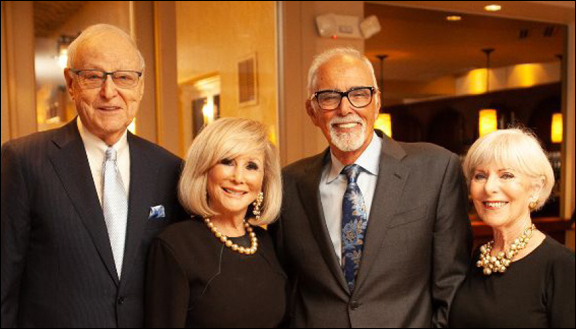
Posted on 12 December 2019 by LeslieM
By Rachel Galvin
Photos by Ryan Cohen

Every year, the Boca Raton Historical Society & Museum (BRHS&M) chooses special individuals and/or institutions to honor by inscribing their name on a granite star on the Walk of Recognition (or listing them on the Wall of Honor if they are deceased). The stars are under part of the commemorative monument beneath the Mizner statue in Royal Palm Place. This accolade is given to people who have worked in some way to enrich the lives of the residents of Boca Raton.
The award was first created in 1997 by Marta Batsmanian, who was present at this year’s ceremony on Nov. 6 along with her husband Jim. The Committee Co-Chairs were Marta Batmasian and Joyce DeVita; and the committee members were Denise Alman and Ann Schauer.
After having a ceremony for placing the name, there was a reception at The Addison restaurant with over 130 in attendance. Following a presentation there for the honorees, guests enjoyed dinner-by-the-bite at food stations with live entertainment in the courtyard.
This year’s honorees were Arthur Adler, Kerry Koen, the late George Barbar, the late Dr. Merrilee Middleton, and Florida Atlantic University.
BRHS&M Executive Director Mary Csar stated, “The Walk of Recognition event was a great celebration of community in a beautiful setting at The Addison. All of the inductees, and their representatives, had powerful and moving stories about their contributions to Boca Raton. I think that every person, who attended the event feels very fortunate to be living in this community. We are proud to be able to recognize people from all walks of life, along with a wide range of institutions, who have made a positive impact on the quality of life here.”
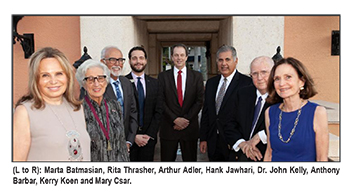
Also mentioned at the event were the new renovations happening at the museum — their History Alive! project to renovate the museum and make it more state-of-the-art and interactive.
The mission and the purpose, of the Boca Raton Historical Society & Museum is to collect, preserve, and present information and artifacts, relevant to the past and evolving history of Boca Raton, and to maintain a visible role in education and advocacy of historic preservation in our community.
For additional information, on the BRHS&M, call 561-395-6766 or visit www.bocahistory.org .
Comments Off on Boca Raton Historical Society & Museum’s Walk of Recognition
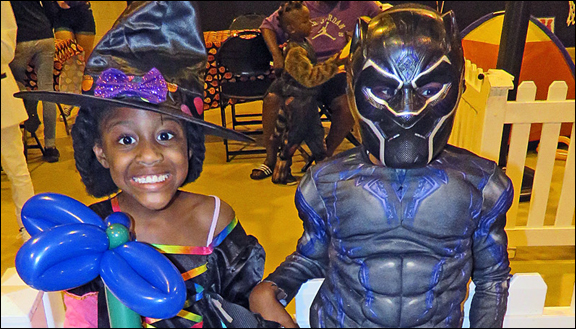
Posted on 11 November 2019 by LeslieM
By Rachel Galvin
Kids ran screaming and laughing out of the Haunted House put together in the Johnny Tigner Center while the main activities were happening next door at the Leo J. Robb Gymnasium at the Oveta McKeithen Recreational Complex in Deerfield Friday night, Oct. 25. This yearly event is always plenty of fun centered around Halloween. Kids, and some parents too, get dressed up and hang out for awhile to partake in the festivities. Kids could bounce in the bounce house, decorate a cookie, play video games and more.
The costume contest on the stage was watched by people on the bleachers, with judges including Velmina Williams, of Kiwanis West, who seems to be on-the-scene at many District 2 events, and Brenda Cox and Grace Dowdell, of Boys & Girls Night Out.
There was a toddler area this year next to a large bounce house. It was being manned by Timouria Bentley and Sarah Charles.
“We have a ball pit, tunnel throw rings and more,” said Bentley.
“It is a safe zone so they won’t get hurt,” added Charles.
Saher Shakil and Camila Vazquez, of Universal Rentals & Events, were creating balloon animals for kids.
“We do local events, from Plantation to Daytona Beach. Today, we are doing balloons. We also do face painting, rentals for bounce houses and more,” said Vasquez.
Aliyah Gowdy, Miss Deerfield Beach USA, was on-site and posed for a picture with Vice Mayor Drosky and Commissioner Hudak. She plans on competing for Miss Florida USA next.
Amanda Cannon does not live in the community, but works as general manager for Five Guys here, which gave out 20 $5 gift cards at the event.
“I am not from this community, but I came out to support,” said Cannon.
Freda Dean came out with her kids Tasheem and Maylasia.
“This is our second year coming. They are both having a ball. They can’t sit still,” she said.
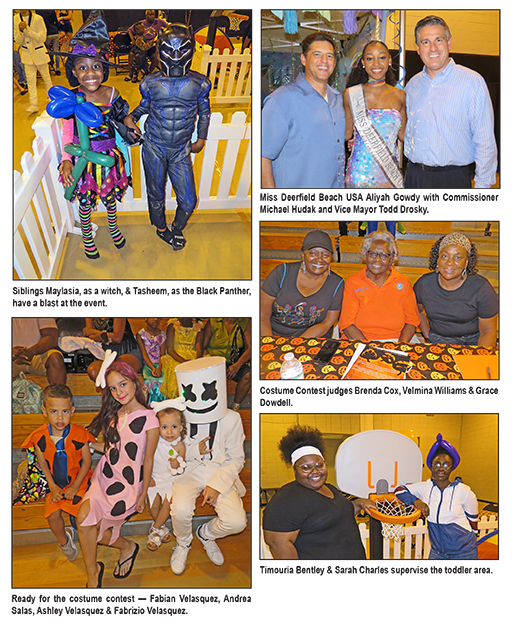
Comments Off on Halloween fun at Oveta McKeithen

Posted on 24 October 2019 by LeslieM
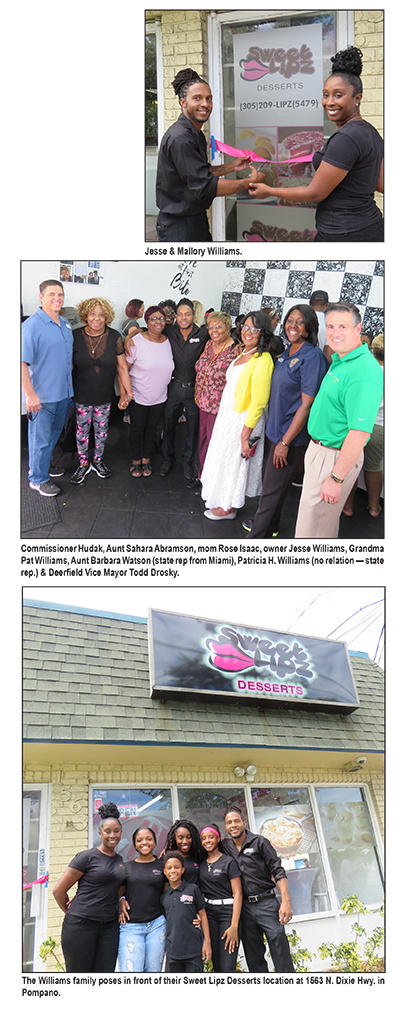
By Rachel Galvin
Our area just got a whole lot sweeter with the addition of a new dessert shop called Sweet Lipz, at 1563 N. Dixie Hwy. in Pompano. You may recognize the name. They also have a food truck and are frequent participants in local events. They held their Grand Opening on Saturday, Oct. 12, which brought in quite a crowd to taste samples of their banana pudding and other delights. This reporter bought a Brookie for $3 (a combination of a brownie and a cookie) and it was delicious! They also had cakes, cheesecakes, cookies, cinnamon rolls and more. Look for new pastries, doughnuts and bread to come soon.
“I just don’t bake. I study food. I learned from my mom and my grandmother …” said owner Jesse “Jay” Williams, who said that Sweet Lipz came from his nickname as he and his brother tried to sneak some samples of desserts as a child.
The whole family was out for the celebration, including grandma Pat Williams, mom Rose Isaac, Aunt Sahara Abramson, Aunt Barbara Watson, who is also a state rep., along with Jay, his wife, Mallory, and his kids Jesse, Jessie, J’lah and Jordan. Come out to grab a sweet treat and meet the family! They are open 6:30 a.m. until 3:30 p.m. They are closed Sunday and Monday.
For more information, visit www.sweetlipzdesserts.com.
Comments Off on Sweet Lipz Desserts Grand Opening
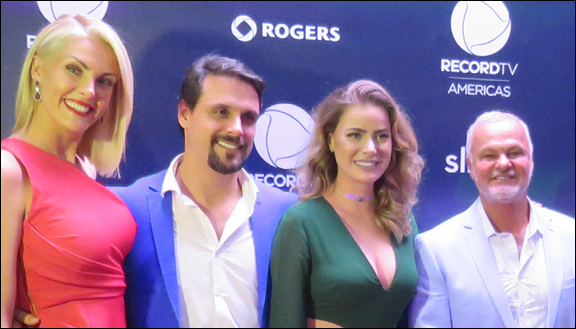
Posted on 16 October 2019 by LeslieM
By Rachel Galvin
Any Brazilian would have been thrilled to attend the 66th anniversary of RECORDTV Americas in its new headquarters in Lighthouse Point on Sept. 27. The star-studded event was hosted by top model and host of Hoje em Dia, Ana Hickmann. Other celebrities spoke, including actors Kadu Moliterno, Rayanne Morais and Felipe Cunha from the telenovela Topíssima, Portuguese basketball star Ticha Penicheiro, MMA fighters Fabrício Werdum, Renzo Gracie and Vitor Belfort, as well as Cake Boss chef Buddy Valastro.
The mayor of Lighthouse Point, Glenn Troast, who helped cut the ribbon, said, “We are very proud to have RECORDTV here in our city. We have worked with them over the last few years to get all the building right, and seeing how it turned out is really wonderful. With the vibrant Brazilian community we have in South Florida, the building will be a true icon for our city.”
Hundreds of guests attended the event, which was in Portuguese, including international journalists, Brazilian diplomats, politicians and company representatives. The President of the Brazilian Tourism Institute (Embratur), Gilson Machado; Ambassador João Mendes Pereira, General Consul of Brazil in Miami, RECORDTV Americas Executive Director Wilon Cardoso and CEO of RECORDTV International Marcelo Cardoso also spoke.
RECORDTV broadcasts content in Portuguese 24 hours a day.The company has been in the U.S. for almost 20 years and continues to expand what they have to offer. Their content can be seen in Portuguese-speaking communities in over 150 countries. They strive to utilize top of the line technology to keep up-to-date with today’s demands.
Visit their website at http://recordtvamericas.com.

Comments Off on RECORDTV Americas opens in Lighthouse Point

Posted on 16 October 2019 by LeslieM
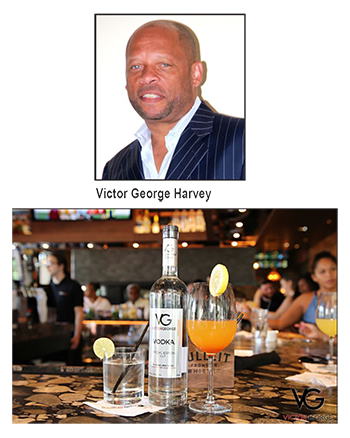
By Rachel Galvin
Victor George Vodka (VG) is popping up everywhere it seems since its official launch back in September. The ultra-premium vodka, which took the silver medal at the San Francisco Wine and Spirits Competition this year, will be the official vodka of the Ft. Lauderdale International Film Festival, 30th Annual Swing for the Kids Golf Tournament at Lago Mar Country Club, Exotics on Las Olas, and will be featured at the Ft Lauderdale Intl. Boat Show and elsewhere. The locally-sourced vodka is gluten-free and uses all-natural ingredients. The filtration and oxidation process they utilize helps to purify and remove harsh congeners and free radicals to make a spirit that is headache and hangover free.
What is more interesting than the vodka is the man behind the brand – Victor George Harvey. His life has undergone a series of twists and turns, but he is back with a commitment to build South Florida’s largest locally owned liquor brand. This go-getter was a college athlete, a rapper (with the name Tai Pan) with a record called “The Rise, The Fall, The Rise,” and his own record label. He got involved in real estate and opened up his first vodka company, called V. Georgio Vodka in 2008. His new vodka, VG Vodka, is already getting a lot of buzz and growing rapidly.
Currently, his vodka is being bottled out of South Carolina, and he is building and opening a distillery on historic Sistrunk Boulevard in Ft. Lauderdale, which will house a tasting room, offices, cigar bar and restaurant.
In addition, he and his two children, both business majors in college, have their own VG clothing line, including boxers, hats and T-shirts, with more merchandise coming soon. A book and movie about his life are in the works. He is certainly one to watch, and look for VG Vodka coming to an event, restaurant, bar or store near you.
For more information, visit www.victorgeorgevodka.com.
Comments Off on VG Vodka is on the scene
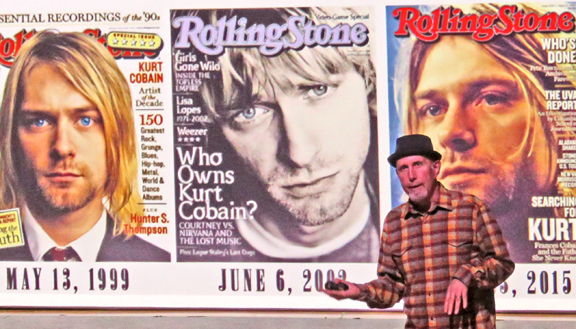
Posted on 10 October 2019 by LeslieM
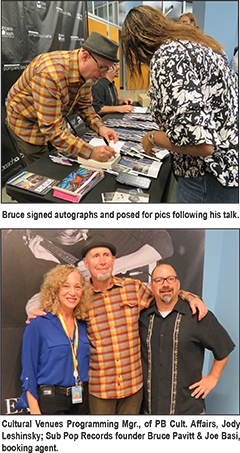
By Rachel Galvin
When grunge came on the scene in the 1990s, the soul-searching rough-around-the-edges musicians were such a departure from the glossed-up, big-haired entertainers that hit the charts in the Me decade that preceded it. One of the biggest names in the flood of newcomers in the ‘90s was Nirvana and the band’s angst-filled frontman Kurt Cobain.
Sub Pop Records owner Bruce Pavitt got to know the tortured artist and gave his insights into him, the band and the evolution of the music industry in a special event held Sept. 21 at the Pompano Beach Cultural Center. The packed audience of about 200 people watched as he showed many of the photos that were taken during a European tour in 1989, pictures that are in his new book called Experiencing Nirvana.
After Sub Pop Records popped on the scene in the late ‘80s, their name and logo became ubiquitous. But few knew the struggles going on behind the scene as Pavitt and his partner Jonathan Poneman spent their time on the phone promoting their artists and sending out materials, working to keep the phone line from being disconnected. They managed heavy hitters in the indie world like Soundgarden and Mudhoney but it seemed that Nirvana might be their golden ticket. They continue to “represent the spirit of independent creativity” to this day.
Cobain, according to Pavitt, was a humble, quiet, sensitive soul. He was an animal lover. He owned gerbils and rabbits. He also had a sense of humor. His simple dreams included having a single played on the local radio station and “maybe opening up a petting zoo.”
He never had an inkling of the fame he would attain. His ripped up jeans, thrown-on vintage thrift store T-shirts and plaid flannel would become part of the look of an age, and people would be devastated when he was gone, a life lost too soon.
There was a glimpse of what lied beneath the artist during that European tour. On one stage in particular, Pavitt mentioned that Cobain “had a nervous breakdown,” jumping up on the PA system and smashing a guitar (which he was known to do). He was distraught. When Pavitt spent time with him trying to understand, Cobain said that when he looked into the audience, all he saw were the kids who bullied him in high school.
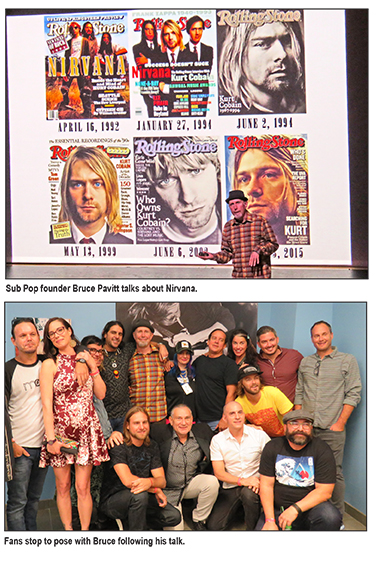
Pavitt talked about how the ‘90s really became very “inclusive.” Instead of people feeling like they were watching an exhibition, they could look at the ‘90s artists and what they were wearing and say, “I have a flannel shirt” (for example), put it on and feel a part of the group. In the ‘80s, everything “felt very excessive,” he said. The clothes, hair and style all were too expensive for the average person.
The feeling of being part of the group that the ‘90s brought was also captured in energetic photos by photographer Charles Peterson, photos used by Sub Pop.
Sub Pop has always been about capitalizing on the independent spirit, the regional market, knowing there is something intrinsic about a sense of tribal identity. Before grunge hit, people couldn’t find Seattle on a map, he said. But, after, a lot of people moved there and the area got international attention as people strove to understand the “Seattle sound.” BBC writer John Peel wrote a great article mentioning Sub Pop in 1989 that helped to get them on the map as well.
Asked where the next regional movement in music is, Pavitt responded, “Los Angeles” and mentioned Billie Eilish, who recently made an appearance on SNL and elsewhere, and graces the current cover of Elle and can be seen elsewhere. She has been around for awhile, but her star certainly seems to have grown brighter lately. Perhaps her rise to fame is because she stands out from the crowd and rebels much in the way Cobain did, although his seemed less purposeful. One noteworthy example is that Cobain refused to be on the cover of Rolling Stone Magazine unless he could wear a T-shirt that said “Corporate magazines still suck.” (Magazine cover in picture above, top left).
Whatever he did, Cobain went from obscurity to one of the biggest stars around in a short period of time. By 1992, he had sold four million copies of his record.
Pavitt added, “Every once in a while, things come together and an artist breaks through. I live for those moments.”
Nirvana would be spirited away by Geffen Records and left Sub Pop behind, but Cobain’s talent and memory made a huge impression on the record label and on Pavitt.
He said, “People would come up to me and tell me where they were when they heard ‘Smells Like Teen Spirit,’” which was on the next album Nirvana did after leaving Sub Pop, telling stories of the impression the music made on people.
Pavitt commented on the evolution of music.
“People don’t buy music. They rent music. It is amazing record stores even exist [mentioning he stopped by Sweat Records in Miami]. Streaming is here to stay,” he said. “[This generation is] not going to read an article. They will read a headline. When I was younger, I read the article, drove to the city, got the record, read the liner notes and thought about it.”
His “manic relationship with music” started at a young age. When he was 9 years old, he worked hard to make money to buy a record player. He never thought he would make money doing this, but said if you are working with people you want to spend time with and doing what you love, then it is not work; it is play.
“There is always going to be art in society, always creative stuff. The trick is getting exposure to creative people,” he said.
There is a movie in the works about his own creative journey and that of Sub Pop, which just celebrated its 30th anniversary on Aug. 11, 2018. For more information on what Sub Pop is up to now, visit www.subpop.com.
Comments Off on Experiencing Nirvana At Pompano Beach Cultural Center

Posted on 10 October 2019 by LeslieM
By Rachel Galvin
The Deerfield Beach Chamber of Commerce’s “You Had Me at Aloha” Happy Hour event held at the Hampton Inn on Sept. 26 was a fun occasion, a way to let off some steam after a day of work. People hung out by the pool and listened to the musical stylings of D. Marion & Company, featuring Ms. Carolyn Dudley. They ate some tropical treats and had some chilly cocktails. They had a chance to talk to their fellow chamber members.
The Chamber always has events coming up, including their Community Heroes Awards on Nov. 8 at 11:30 a.m. at the Wyndham Resort. Look for more on that soon. For more information, visit www.deerfieldchamber.com.
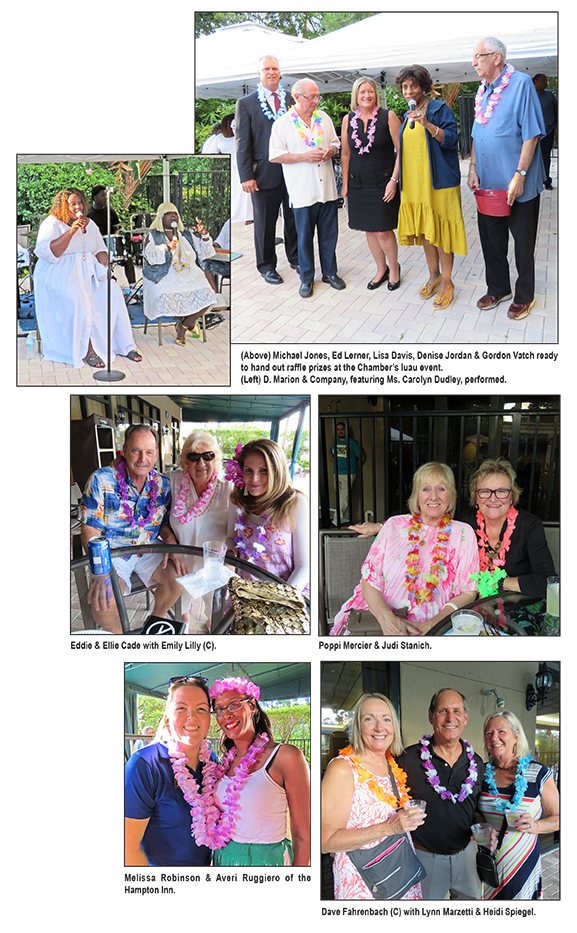
Comments Off on You had me at Aloha
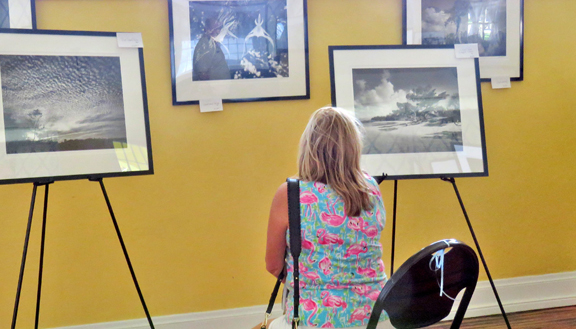
Posted on 19 September 2019 by LeslieM

By Rachel Galvin
A glimpse of the paradise in our own backyard and beyond is captured in large scale black and white photographs created by prolific photographer Clyde Butcher, whose work is currently on display at the Old School House at 232 NE Eller St. in Deerfield Beach. The exhibit started on Sept. 7, runs Saturdays from 10 a.m. to 2 p.m. until Sept. 28. $5 (donation). You can also buy one of his books or a book on Deerfield history and other items.
When asked why the Historical Society brought his artwork to be on display, Historical Society President Emily Lilly said, “I’ve appreciated his work for many years. I love the reasoning behind his photos. They not only tell a story, but tell us to look at the environment in an appreciative way. He has been one of my educators. He’s expressed the love of our state and beyond and that’s what I like.”
“Clyde’s photography is definitely a personal experience,” said Poppi Mercier, who was volunteering at the event on Saturday, “Everybody loves it. The Historical Society is thrilled. It is surprising how many people have seen his work before and still come back for more. I can understand it. Every time you look at it, you see something totally different. The black and white makes you pay attention to the details.”
For more information on Clyde Butcher, visit www.clydebutcher.com. For more information on the historical society, visit www.deerfieldbeachhistoricalsociety.com/
The Historical Society is participating in Free Museum Day on Sept. 21. Not only will this exhibit be open, but also the Butler House, as well as the local train museum, all for free. See ad on this page for details.
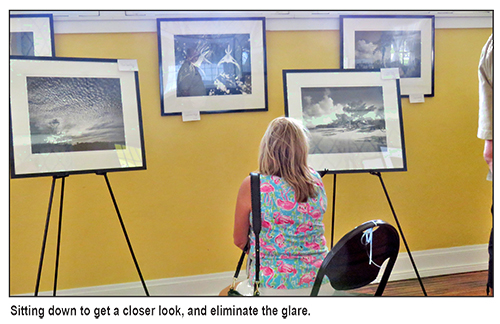
Comments Off on Clyde Butcher Shares a piece of paradise
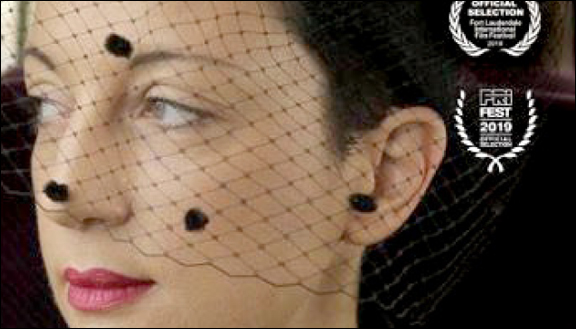
Posted on 19 September 2019 by LeslieM
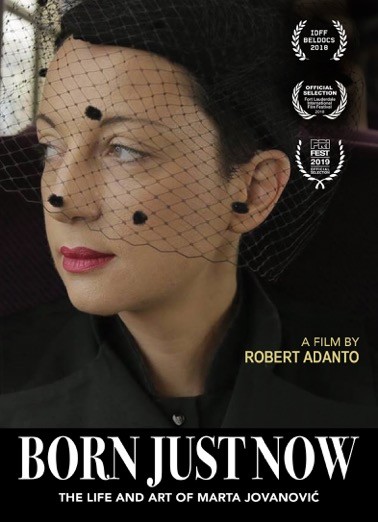
By Rachel Galvin
For Marta Jovanović, art is everything. Her medium of choice is herself, whether she is smashing eggs, being tied up, or having pig hearts pelt her body. Her performance art is entrancing and inviting, as she welcomes the viewer into what she is trying to convey. She covers topics from what it is to be a woman and an artist, to finding beauty in unique places, to the brutality and heartbreak of war and conflict.
The unfolding of her story is brilliantly told by documentary filmmaker Robert Adanto. With captivating and, at times, disturbing visuals, he follows the life of this Serbian artist, who has suffered through an abusive relationship, the misunderstanding of her work and the accusation that she has wasted her life on art rather than creating a family.
You can feel her angst, her anger brewing inside waiting to bubble out. Like a rebel punk, Jovanović is filled with fury but, instead of exploding it out, she channels it in specific and thought-provoking ways that push the boundaries. She sets fire to convention in the same way she lights her old wedding dress on fire, burning away thoughts of her ex-husband and letting that dream that once was die away, while perhaps unveiling something about relationships and what they should and should not be.
There is a certain freedom in it and that is something she seems to have in spades, but does she really? Like all of us, she struggles with her own identity, but, in her case, she holds it up, like an open wound for the world to see, throwing caution to the wind and shoving it in the faces of art-loving bystanders whether they like it or not.

Adanto has created another masterpiece with this film. Like his previous films: The Rising Tide, Pearls on the Ocean Floor, City of Memory and The F Word, Born Just Now focuses on art and culture and makes celluloid magic. His films have been shown in over 40 international festivals, as well as having exhibitions in museums and elsewhere worldwide. Adanto is a fellow of the Sundance Institute Documentary Program and earned his MFA in Acting at NYU Tisch School of the Arts. He was the head of the Film and TV Production program at NSU University School from 2012 to 2016, but now is teaching speech & debate and Model UN at the Ethical Culture Fieldston School in the Bronx, NY.
Adanto met Jovanović in 2013 when doing follow-up interviews for The F Word, which explores feminist performance. One of the people he interviewed suggested maybe adding Jovanović into the mix for that film, but when he read a book she gave him about Jovanović, he realized that her work would be better showcased in a film all its own. He spoke with her and decided to start shooting in 2016. Production began in Belgrade and he had a small crew of locals there help him with shooting, in addition to shots he had a second cinematographer capture in New York.
Born Just Now made its UK-premiere last week in London and will be screening in Buenos Aires, Argentina at the end of the month. Clips from his past art documentaries are in a special exhibition at the Art & Culture Center in Hollywood called F.A.R. (Female Artists Revealed), which will be on display until Oct. 27.
Born Just Now is coming here to the Pompano Beach Cultural Center (50 W. Atlantic Blvd., in Pompano Beach) on Sept. 26 at 7 p.m. as part of their Montage film series. Tickets are $10 and can be purchased at the door. To purchase tickets and for more information, visit www.ccpompano.org.
Comments Off on Born Just Now documentary At Pompano Cultural Center Sept. 26